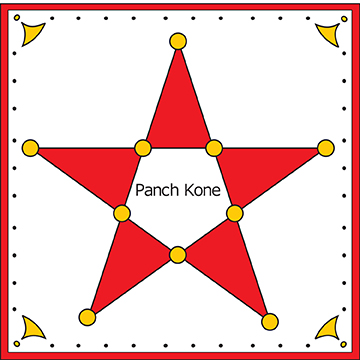Registered with the Registrar of Newspapers for India under R.N.I 53640/91
Vol. XXXII No. 20, February 1-15, 2023
Lost Leisure: The Mystery of the Pink Granite Stone with the Game of Panch Kone — Kapaleeshwarar Temple
-- by Vinita Sidhartha
Traditional games have a rich and interesting history. There is much we know about them, and there is much that we don’t. In some cases, we remember the rules, the names, and how we used to play them. But who created them? Where did they come from? Is there a deeper meaning? Of this we know next to nothing. There is no creator for these games. No copyright we can assign to the originator of the idea. But we have numerous clues about them from etchings on the floors of temples and monuments. They don’t always provide answers; in fact, they sometimes give us questions, puzzles and mysteries, that force us to dig deeper and understand more and more about them.
The Kapaleeshwarar temple has long been a center of commerce and cultural activity. Naturally people congregated there and as expected, numerous traditional games are found engraved there. In 2009, when we explored the temple, we found almost nine distinct game boards. Unfortunately, many have disappeared during renovations to the Temple.
 Panch Kone.
Panch Kone.When another foray was made in 2021, to record the games in the temple, we found that many games had disappeared, but some were still visible and clearly engraved on the floor. Among these, is the pattern of the five-pointed star on which is played the game of Nakshatra Vilayattu or Panch Kone.
Predominantly a single player game, it challenges the player to remove game pieces from the board following a set of rules, or place game pieces on the board following a different set of rules. Unlike the card game of solitaire, which tends to be based purely on chance, this game urges the player to explore, to strategize, to think of patterns, of formulae that can help one achieve these goals.
While this game is found in numerous temples, what makes it a curiosity here is that it is carved on a stone of pink granite evidently brought in from somewhere else during renovations to the temple. While the pink granite stands out starkly against the rest of the grey, the game itself has eroded over time. One has to look at it from a certain angle and may be dust a little kolam powder into the grooves to actually see the star.
The next time you are at the temple and stand facing the Subramanya Swami Sannadhi, look to the left and you will see the pink granite slab and the faint lines of the board.
Where did the pink granite come from? Where was the game carved? We don’t know and we may never know. But this wonderful puzzle has been brought to us at the Kapaleeshwarar temple to further coax us into studying, understanding and exploring the world of traditional games.
Keep reading, there are so many more puzzles, but to understand these, we need to preserve our games and protect our floors, for in them we could well have the answer to not just our questions on games, but much of human philosophy and thinking. To know more write to me at vinita@kreedagames.com

